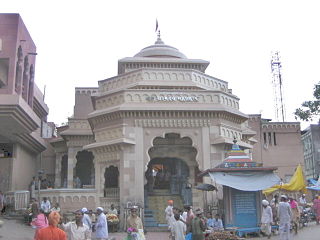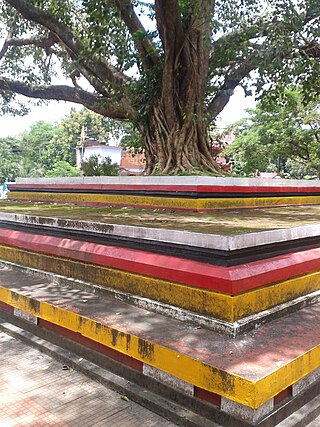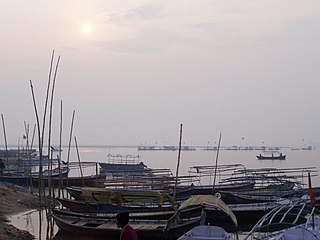
Koodli, also spelled Kudli or Kudali, is a small historic village in Shimoga District, in the Indian state of Karnataka. It is at the sangam (confluence) of two rivers, the Tunga River and Bhadra River at nearly 1,200 metres (3,937 ft). They meet here to give rise to the Tungabhadra River, a tributary of the Krishna river. Their valleys host many architectural sites. The village was a much larger town and pilgrimage center before the 14th-century, one destroyed during the Islamic conquests of the south. Important temples and their ruins here include the Jagadguru Sri Shankaracharya Dakshinamnaya Sringeri Sharada Peetham, Sangamesvara temple, Ramesvara temple, Sri Chintamani Narasimha temple, Sringeri Vediki temple, Vishwakarma temple, Sharadamba temple, Amma Devasthana, and the Brahmeswara temple. Other scattered ruins of unknown temples are also found here.

The Koyna River is a tributary of the Krishna River which originates in Mahableshwar, Satara district, western Maharashtra, India. It rises near Mahabaleshwar, a famous hill station in the Western Ghats. Unlike most of the other rivers in Maharashtra which flow East-West direction, the Koyna river flows in North-South direction. The Koyna River is famous for the Koyna Dam and the Koyna Hydroelectric Project. Koyna Hydroelectric Project is the 2nd largest completed hydroelectric project in India. The reservoir – Shivasagar Lake, is a huge lake of 50 km in length.

Pandharpur is a Popular pilgrimage town, on the banks of Chandrabhagā River, near Solapur city in Solapur District, Maharashtra, India. Its administrative area is one of eleven tehsils in the District, and it is an electoral constituency of the state legislative assembly. The Vithoba temple attracts about a million Hindu pilgrims during the major yātrā (pilgrimage) in Ashadha (June–July).
Wai is a town in Satara district of Maharashtra state in India. Located on the Krishna River, Wai was a prominent town during the Peshwa era. Two important Marathi Brahmin from ruling families had their origins here: Rani Lakshmibai of Jhansi and Gopikabai, wife of Nanasaheb Peshwa.
Prabhas Patan, historically named Dev Patan, is locality in Veraval, Gujarat. As the site of the Somnath temple and its associated Jyotirlinga, it is an important place of Hindu pilgrimage.

Devprayag is a town and a nagar panchayat, near New Tehri city in Tehri Garhwal District in the state of Uttarakhand, India, and is the final one of the Panch Prayag of Alaknanda River where Alaknanda meets the Bhagirathi river and both rivers thereafter flow on as the Ganges river or Ganga.

The Early Cholas were a Tamil kingdom of the Chola Dynasty - pre and post Sangam period. It was one of the three main kingdoms of Tamilakam. Their early capitals were Urayur or Tiruchirapalli and Kaveripattinam. Along with Pandyas and Cheras, Chola history goes back to the period when written records were scarce.

Pazhayangadi, is a small township, approximately 23 km (14 mi) north of district headquarters Kannur, 15 km (9.3 mi) south of Payyanur and 14.5 km (9.0 mi) west of Taliparamba in the Indian state of Kerala. In the local language of Malayalam it literally means "Old Market". The town is bounded by the Madayi Hills (Madayippara) on the west and by the Pazhayangadi River on the south. Ezhimala, a range of hills, that is believed to be home to a variety of medical herbs including mrithasanjeevini, and a very ancient recorded history, is situated nearly 8 km west of Pazhayangadi. Pazhayangadi town is spread over Madayi and Ezhome Grama Panchayats. Madayi Hill offers a splendid scene of Ezhimala which means a chain of seven mountains, where the Indian Naval Academy is situated.

Karad is a town in Satara district of Indian state of Maharashtra. It is located 302 km (180.19 miles) from Mumbai, 74 km from Sangli and 162 km from Pune. It lies at the confluence of Koyna River and the Krishna River known as the "Pritisangam". The two rivers originate at Mahabaleshwar, which is around 100 km from Karad. Karad is well known for sugar production and is known as the sugar bowl of Maharashtra owing to the presence of many sugar factories in and around Karad. It is considered an important educational hub in Western Maharashtra due to the presence of many prestigious educational institutes. Karad is resting place of the first chief minister of Maharashtra Yashwantrao Chavan situated at the confluence of the Krishna and Koyana rivers. It is ranked as the cleanest town in Swachh Survekshan 2020 in the category of population with less than 1 lakh.

Keshoraipatan is a city located in the state of Rajasthan, India. The town is famous for the temple of Keshav Rai Ji Maharaj or Lord Vishnu which lies on banks of the Chambal River. The town is 20 km from the well known education hub of India, Kota. Mratunjaya Mahadev temple is another important shrine of the town. The temple is one of the oldest temples of Rajasthan. There is a very old Jain temple of lord munisuvrat in the city. Kalyanrai temple is old temple of Keshavraiji. Here is a Teela where coins and many ancient things are found. There is "pandav shala" also located here. It is said that in exile period Pandavs came here. Kartik Poornima, Bundi Utsav, Taijaji Ki Ghodi and Dhol Gyaras are some famous festivals in Keshoraipatan. Many devotees take a bath in the Chambal River during Kartik poornima.
Tasgaon Tasgaon is a city in Maharashtra and Taluka in Sangli district in the Indian state of Maharashtra. Tasgaon city is developing city in Maharashtra. Tasgaon was given as Jahagir to Parshuram Bhau Tasgaonkar by Narayanrao Ballal Peshwa in 1774. Tasgaon Sansthan was lapsed by British during ruling of Shrimant Ganpatrao Tasgaonkar.

In Hindu tradition, Triveni Sangam is the confluence of three rivers that is also a sacred place, with a bath here said to flush away all of one's sins and free one from the cycle of rebirth.
Fatuha also spelled Fatwah or Fatwa, is a Satellite town in proposed Patna Metropolitan Region, in the Patna district in the Indian state of Bihar. Fatuha lies 24 km east of Patna the capital of Bihar. Fatuha is an important industrial centre known for small industries and its handloom industries. The city's name is said to come from its status as a center of textile manufacturing.

Alopi Devi Mandir is a temple situated in Alopibagh in Prayagraj in state of Uttar Pradesh, India. It is near to the holy Sangam, or confluence, where the rivers Ganges, Yamuna and the legendary Sarasvati meet. Kumbh Mela is near to this place.
Daraganj is a prominent suburb and a landmark in the city of Prayagraj. It is the oldest suburb of Prayag at the bank of celestial river Ganges and not far from Triveni Sangam - the confluence of three sacred rivers: the Ganges and Yamuna, and the third invisible river Saraswati. Thus, Daraganj is essentially a theoretical and philosophical reference point of city now called Prayagraj.

Situated in the northern part of India, bordering with the capital of India New Delhi, Uttar Pradesh is one of the most popular and an established tourist destination for both Indians and non-Indians alike in India. The most populous state of India, Uttar Pradesh contains many historical monuments and places of religious significance. Geographically, Uttar Pradesh is very diverse, with Himalayan foothills in the extreme north and the Gangetic Plain in the centre. It is also home of India's most visited sites, Hinduism's holiest city, Varanasi. Kumbh city, Prayagraj. Kathak, one of the eight forms of Indian classical dances, originated from Uttar Pradesh. Uttar Pradesh is at the heart of India, hence it is also known as The Heartland of India. Cuisine of Uttar Pradesh like Awadhi cuisine, Mughlai cuisine and Bhojpuri cuisine are very famous not only in India but also many places abroad.

Uppinangady or Ubar is a town in the Puttur talk of Dakshina Kannada district in the state of Karnataka, India. It is surrounded by the Kumaradhara River on one side and Nethravathi River on the other. When the town's two surrounding rivers rise during the rainy season and meet, this is called the "Sangam" which is a Sanskrit word for confluence. The Sangam is a major event as people from the surrounding villages crowd the river banks to witness the merge. The population of Uppinangady is 7,172.
Shukachari is a hill place located in the hill ranges known as Mahadev Hills between Atpadi and Khanapur of Sangli district, Maharashtra, India. As per Puran this place is believed to be the place of the epic sage Shukamuni or Shuka, son of Vyas. This is a very popular place in Atpadi taluka, people come from all the places of taluka as well as from outside. This is famous for Big Stones & Dark Forest as well as a water source in between mountains.
Uttarakhand is a state in the northern part of India. It is often referred to as the "Devbhumi" due to its religious significance and numerous Hindu temples and pilgrimage sites found throughout the state. As a result, religious tourism forms a major portion of the tourism in the state. Uttarakhand is known for the natural environment of the Himalayas. 2019 Tourist Arrivals Domestic – 40,000,000 per/year and Foreigner – 150,000 per year. Tourism business in Uttarakhand generated ₹ 23,000 crores during 2013–14.

Parihaspora or Parihaspur or Paraspore or Paraspur was a small town 22 kilometres (14 mi) northwest of Srinagar in the Kashmir Valley. It was built on a plateau above the Jhelum River. It was built by Lalitaditya Muktapida and served as the capital of Kashmir during his reign.














